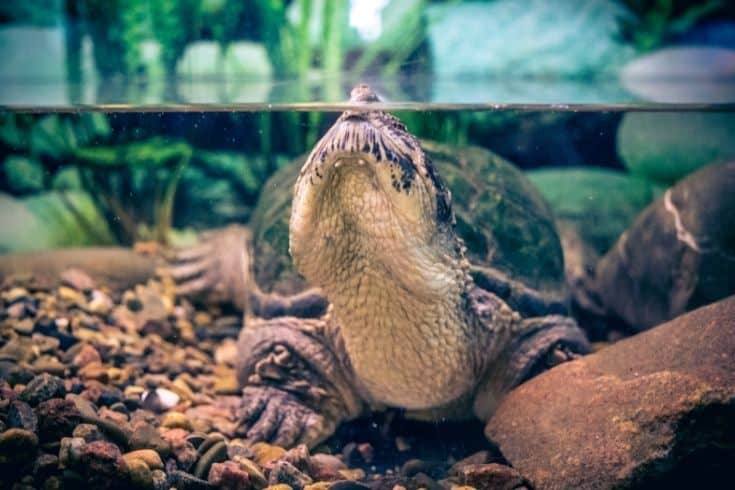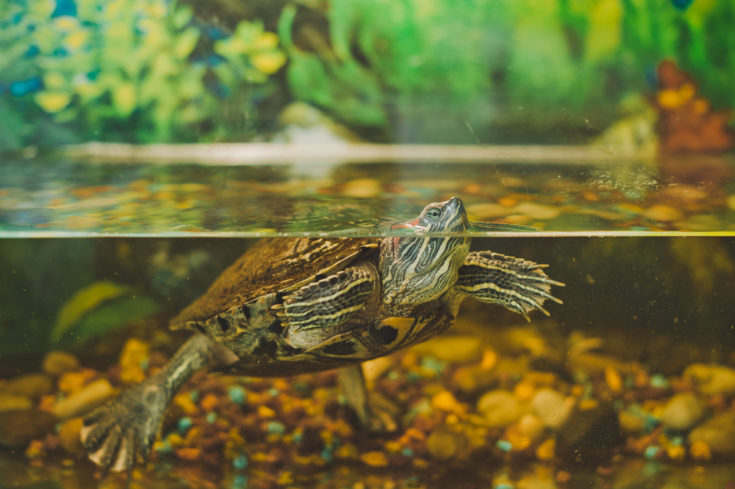Turtles are known for their longevity and the seemingly extraordinary powers of passive defense and adaptation they possess. Their hard shells allow them to survive injuries and exposure to the elements, acting as a natural shield against harsh conditions. But these tough exterior coverings may not be enough to prevent them from dying in the confines of captivity.
Try as you may provide the best care possible, there are times when it seems like your turtle is determined to succumb to its environment. Although this may be true in some cases, the following article will cover some of the most common reasons for turtles dying in captivity and provide you with ways to increase their chances of survival.
7 Signs Of A Dead Or Dying Turtle

As with most animals, turtles are known to act abnormally when they are sick or dying. Their behavior can change rapidly and their activity levels may decrease significantly. Under these circumstances, knowing how to identify if your turtle is sick or close to death could save its life. Here are 7 warning signs you should look out for:
You Smell A Bad Odor
Foul odors are a key indicator of a disease, especially long before any physical symptoms are apparent. When your turtle has a bacterial infection or some other illness that’s causing it to slowly die, then you will most likely notice an odor emanating from its habitat.
Other illnesses that might cause an annoying odor include fungal infections, which are common in turtles that have constant moisture on their shells. If you notice a bad smell around your turtle’s habitat but not coming from the animal itself, then it could be another sign of infection or death seeping through.
Finally, a particularly offensive odor can also be caused by the active decay of a dead turtle that has been left to decompose in the tank. Ideally, you want to remove its body from its habitat before it reaches a state of advanced decay. This will prevent the bad odor from becoming overpowering and ensure that your tankmates remain safe
You Notice A Disruption In Your Pet’s Everyday Routines
In order to ensure that they get the most out of life, turtles tend to have a strict routine. They eat at roughly the same time each day and spend most of their waking hours performing routine activities, whether it’s basking in the sun or swimming through their tanks.
When your turtle starts to die, this daily structure will gradually begin to collapse. It might refuse food altogether, and its usual basking spots may also start to disappear as it begins to lose interest in sunlight and warmth. Your usually lively turtle may start acting in a lethargic manner.

If you notice disruptions in your pet’s daily routines, then it’s possible that the end might not be far off. An active turtle that has suddenly stopped eating may have just fallen ill. But one that appears to have given up on life could be days away from death, especially if you find that its usual spots in the tank are no longer in use.
Your Turtle’s Shell Is Disfigured
Once your turtle becomes sick, you will immediately notice physical changes in its shell. The shell should always be smooth and clean, but if it is dying then it will start to develop deep cracks or other irregularities that can make it look disfigured.
These irregularities are caused by bacterial or parasitic infections that slowly make their way throughout your turtle’s body. You may also observe other symptoms that can help you pinpoint the exact nature of the illness – such as swollen eyelids or flaking skin. The shell may also become discolored, which can be an early warning sign of fungus or other skin lesions.
In short, any deformities in your pet’s shell could indicate the presence of a slow-moving disease that might soon cause its death. Even if your turtle is eating and active, these physical changes should still be taken seriously. Always err on the side of caution when it comes to your pets!
You Have A Non-Moving Turtle — And It Isn’t Its Hibernation Period

Hibernation in tortoises is not necessary, but it’s still common for turtles to sleep through the colder months of the year. Those that do so will make plans ahead of their actual hibernation times, either by burrowing themselves deep into the substrate or finding a cool spot under their basking platform.
If your turtle hasn’t started making hibernation preparations, then there’s a good chance that it may be terminally ill. A non-moving turtle with no symptoms of hibernation is likely to have contracted some other illness that has attacked its body over the course of several weeks or months.
These pets are usually easy to spot, as turtles that aren’t hibernating have a tendency to remain on top of their substrate even during warmer nights. They also tend to crawl around their tanks less, with some exceptions.
Your Pet’s Breathing Becomes Very Weak Or Unusual
Most people are able to determine whether or not a turtle is dying just by observing its breathing condition. Healthy turtles breathe naturally throughout the day and night, with their chests expanding fully when they inhale and deflating when they exhale.
If your pet is terminally ill or has a respiratory infection, its breathing may become labored or unusually quiet. It might not breathe at all during the day, although this problem can often be fixed by soaking it in water or misting it with a spray bottle.

There are many other symptoms that can help you pinpoint the nature of your turtle’s respiratory illness, including wheezing sounds, bubbles coming out of its nose, and discharges from its eyes. Before you attempt any home remedies to fix your pet’s respiratory problem, take it to a veterinarian that can offer professional treatment.
You See A Bloated Body
Most turtles naturally accumulate fat deposits to help them survive hibernation, but these fat deposits are not visible unless it is extremely overweight. Obese turtles can become sick if they gain too much weight in a short amount of time, as this can cause their body systems to shut down.
A bloated body might also be an indication that the decomposition process has begun. The accumulation of gases can cause your pet’s body to swell, while its shell might also feel softer or weaker than usual. These gases are unable to escape via your pet’s air holes because they’re blocked by its deteriorating skin.
Therefore, bloating can be a key sign that your turtle is dead or dying. Keep an eye out for other signs that can help you pinpoint the exact nature of your pet’s condition, such as its lack of appetite, changes in its breathing patterns, or in the case of death, a foul scent coming from its body or enclosure.
Preventing Deaths And Illnesses
Death in any animal is always a regrettable circumstance, especially when it comes to our beloved pets. But with proper care and preventative measures, you can keep them alive and well for many years to come. Here are some things you can do to give it a long and healthy life:
Regular Veterinary Exams
Consider getting your turtle regular examinations from an exotic animal veterinarian, especially if you notice any changes in its appetite or behavior. These vets can diagnose and treat a wide range of conditions using accurate methods and medications. Timely intervention can sometimes save your pet’s life, so act quickly.
In addition, part of responsible health care is minimizing all instances of illnesses, to begin with. An exotic animal vet can also give you advice on how to keep your beloved companion in peak health, including the types of vitamins and foods that it should have access to at all times.
Prevention Through Diet
Just like you and I, turtles need a balanced diet to stay healthy and ward off illness. Many commercial pellets offer the right balance for young, growing pets. But as they reach adulthood, you might need to supplement their diets with fresh food to give them all the nutrients they need to maintain their health.
Some turtles are pickier eaters than others, so check out the types of food they like best before purchasing them. If you suspect that your pet isn’t eating enough, try adding some vitamins and calcium to its food. Even if you have a finicky eater on your hands, there are still many nutritious foods that you can offer on a regular basis.

Remember that although most turtles are herbivores, they still require protein sources to stay healthy.
Help It Maintain An Ideal Body Temperature
Turtles are cold-blooded animals that require stable body temperatures to survive. If your turtle’s tank is too hot or too cold, it can cause various diseases and conditions that reduce its lifespan. Colder temperatures in particular can make them feel sluggish and weak, while warmer temperatures can make them dehydrated.
For this reason, most turtles need basking areas with an optimal temperature of between 75 °F (23 °C) and 85 °F (29 °C). This is especially important if it is ill or is in the last days of its life. You can usually provide your pet with this type of basking area by using a heat lamp or heat mat, but check that your pet’s skin doesn’t feel too hot to touch before you do so.
For more tips on how to create the ideal turtle tank setup, check out this article.
Provide Fresh Water
Turtles are messy animals that produce a large amount of waste, so they need clean water and living spaces at all times. Invest in a good canister filter for turtle tanks to keep water parameters under control. Remember to remove all of its waste and add clean water every day or two. Dirty water can worsen an existing condition or cause new health problems, so always be diligent with your turtle’s tank.
When in doubt, know that a turtle’s ideal habitat contains a few inches of water in a safe basin that has room for it to crawl out and dry itself. Use a tight-fitting lid to prevent it from falling in or getting trapped inside, and don’t let it enter the water if its body temperature is below 86 °F (30 °C). Lukewarm water is usually the most comfortable for these creatures
Helping Your Sick Or Dying Pet
In spite of your best efforts, death and illnesses can sometimes be inevitable. However, providing your pet with proper care under these unfortunate circumstances can make all the difference. Not only will this increase its chances of survival, but it will also make the process less traumatic for you as an owner.
Since these animals cannot tell us how they feel, it is up to us to do our best to keep them healthy and avoid infections. If you find that your pet is ill or dying, here’s a step-by-step guide to providing it with comfort during this trying time:
Step 1: Identify The Problem
Before doing anything, identify the primary cause of illness or injury in your turtle. Has it fallen ill recently? Has it experienced any recent changes to its diet, habitat, or environment? If you can pinpoint the cause of an ailment or accident, then you will be able to focus all your efforts on the solution.
Step 2: Try To Get Your Pet Back On Track
If your pet turtle’s ailment is not too severe, you might be able to bring it back to optimal health by making a few changes in its environment and diet. Try feeding it with healthy foods, providing a basking area with the proper temperature, and letting your pet rest a while. If it has been injured, keep a close eye on its shell and tail for any problems.
Step 3: Seek Professional Assistance
If your pet is very sick or severely injured, you might need to seek professional help. If there are signs of serious infection around its eyes, mouth, or shell, then it’s time to get medical care for your pet. Don’t hesitate to take it in immediately if you see any symptoms. Even if it is dying, the veterinarian might be able to prolong its life with a few medications and proper care.
Step 4: Provide Necessary Treatment
Finally, you must provide the necessary treatment. If your pet is only slightly ill or has contracted a minor infection, you can treat its symptoms at home with antibiotics or other medications. If you have consulted a vet or aquatics specialist, administer the prescribed medications in accordance with their instructions.
Step 5: Consider Euthanasia As A Viable Last Resort
If your turtle is in significant pain or its condition can’t be treated, you should consider euthanasia. Making this decision can be difficult, so consult a vet for more information on different euthanasia methods to help you with your decision. We’ve also written an article on a list of factors to consider before euthanizing a pet. While it focuses on fish, the general principles mentioned applying to turtles as well.
If you plan on euthanizing your pet yourself, opt for a humane method such as the fridge method, which involves putting its body in a freezer for a few days. Your final goal should be to keep your pet turtle comfortable and stress-free during its remaining time on Earth. By following these simple steps, you can ensure that your pet lives the best life possible even when it’s facing death or injury.
Conclusion
As upsetting as it can be to think about your beloved pet falling ill or dying, knowing how to identify the signs of impending death or a serious illness can allow you to provide it with the care and medical it needs to stay comfortable.
Remember that most pet turtles live for about 20 years – this means that they are with us for a long time! The information above can help us make the best possible decision for ourselves and for our pets. At the end of the day, the goal is to provide the best life possible for our pet turtles – even when they are on their way out.
Did you enjoy this article? Let us know what you think in the comments below, and please don’t forget to share it with fellow turtle enthusiasts on social media! Thanks for reading, and I’ll see you next time.
